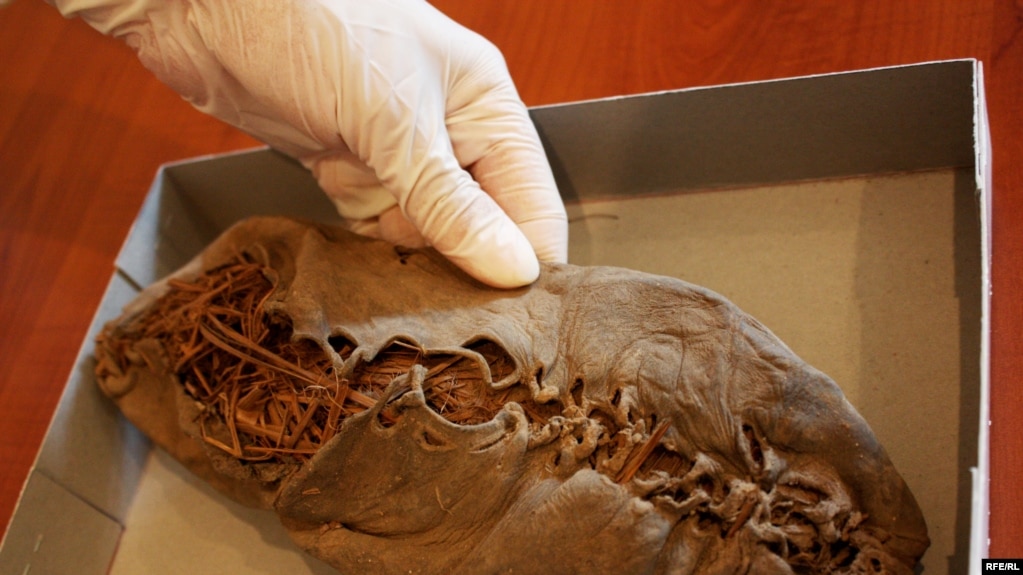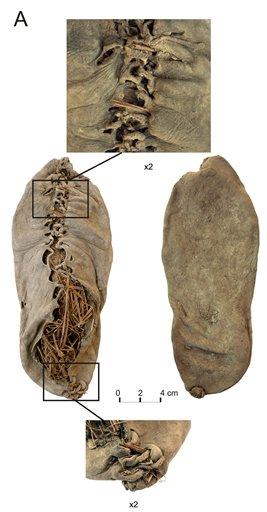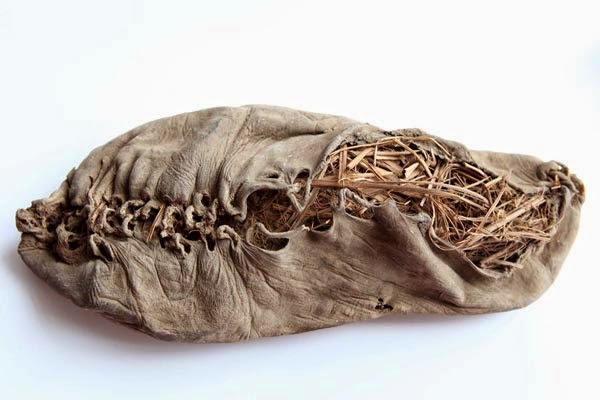A 5,500-year-old leather shoe – complete with laces – has been unearthed in cave in Armenia.The perfectly preserved shoe – 1,000 years older than the Great Pyramid of Giza and 400 years older than Stonehenge.
YEREVAN — The world’s oldest leather shoe — 400 years older than Stonehenge and 1,000 years older than the Great Pyramid of Giza — has been found perfectly preserved in a cave in Armenia.

The 5,500-year-old shoe was discovered by a team of international archaeologists, who reported details of their finding on June 9. The shoe is made of a single piece of cowhide leather, with intricate laces, and was shaped to fit the wearer’s right foot.
It is 24.5 centimeters long — a relatively diminutive size 37 by contemporary European standards, or U.S. women’s size 7 — and dates back to around 3,500 BC, an era known as the Chalcolithic period, or Copper Age, when humans are believed to have invented the wheel, domesticated horses, and produced other innovations.
The shoe was found in a cave in the Armenian mountains in 2008 by Diana Zardaryan, a doctoral student at the Institute of Archaeology and Ethnography at the Armenian National Academy of Sciences. The shoe was stuffed with grass and had been perfectly preserved under layers of sheep dung.

Zardaryan, in a published account of the extraordinary find, said she was “amazed” to see that even the shoelaces were preserved.
Pavel Avetisian, the institute’s director, told RFE/RL’s Armenian Service the find was “unique.”
“Usually leather doesn’t survive in soil. Exceptional conditions are needed for buried leather items to be preserved,” Avetisian said.
Scientists at radiocarbon laboratories in California and Oxford, England, have been working since 2008 to accurately determine the age of the shoe.
“We’ve had dozens of tests at the world’s leading laboratories, to make sure that we don’t spread any unverified information to the world,” Avetisian said.
Fiber Before Leather
The oldest known footwear in the world is a pair of fiber sandals thought to be around 2,500 years older than the Armenian leather shoe. They were found in a cave in Missouri in the United States.
Ron Pinhasi of University College Cork in Ireland led the team of Armenian, Irish, and U.S. researchers working in the Armenian cave since 2007. He said while it was small, the shoe “could well have fitted a man from that era.”
The cave where the discovery was made is in Armenia’s southeastern Vayots Dzor province. Pinhasi said the stable, cool, and dry conditions in the cave meant the various objects found there were very well preserved.
The team said preservation was also helped by the fact that the floor of the cave was covered by a thick layer of sheep dung which acted as a solid seal over the objects, keeping them safe for several millennia.
Other finds included large ceramic containers, many of which held wheat, barley, apricots, and other edible plants, as well as the skulls of three adolescents with what Avetisian described as brain remnants.
“Clay vessels found there are such that we presume they had also distilled wine there,” he said. “If ongoing laboratory tests confirm that as well, it will mean we have found the world’s oldest wine-making facility.”
“It’s sort of a Pompeii moment, except without the burning,” Mitchell Rothman, an anthropologist and Chalcolithic expert at Pennsylvania’s Widener University, told “The New York Times.” “The shoe is really cool, and it’s certainly something that highlights the unbelievable kinds of discoveries at this site.”
“The larger importance, though, is where the site itself becomes significant. You have the transition really into the modern world, the precursor to the kings and queens and bureaucrats,” said Rothman, who was not involved with the discovery.
The paper also quoted Adam Smith, another American anthropologist who has done separate research in the cave, as saying: “It’s an embarrassment of riches because the preservation is so remarkable.”

According to Avetisian, the American and Irish researchers will return to Armenia this week to continue exploring the cave, which has been given the designation Areni-1. He said the Armenian side also needs their expertise and advice on how to preserve the shoe at the National History Museum in Yerevan, where it is due to be put on permanent display.
“When we unearthed the shoe, it was very soft and flexible. But we can now feel that it is slowly hardening,” Avetisian explains. “American specialists are now working on that problem, and some time later they will tell us how to preserve it and in what conditions.”
Related Post
A shocking documentary proves that mermaids do exist
SHOCKING Revelation: Thuya, Mother of Queen Tiye, Was the Grandmother of Akhenaten and Tutankhamun—What Ancient Egyptian Secrets Did She Leave Behind?
Breaking News: Astonishing Discoveries at Karahan Tepe Confirm an Extraterrestrial Civilization is Hiding on Earth, and NO ONE Knows!
Breaking News: Researchers FINALLY Discover U.S. Navy Flight 19 After 75 Years Lost in the Bermuda Triangle!
NASA’s Secret Investigation: Uncovering the Astonishing Mystery of the UFO Crash on the Mountain!
Explosive UFO Docs LEAKED: Startling Proof That Aliens Ruled Ancient Egypt!